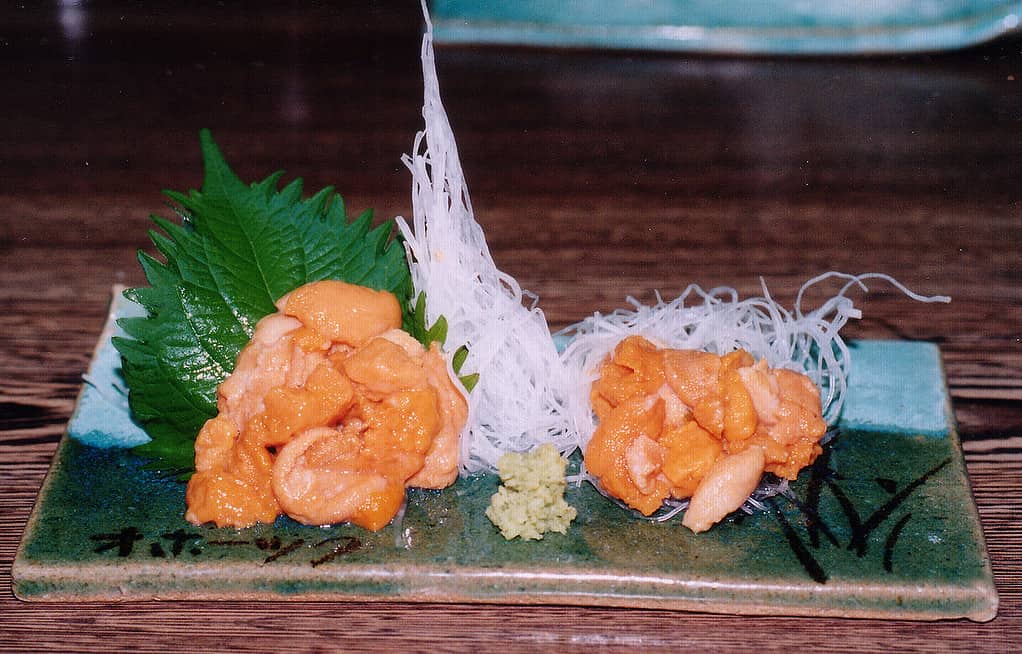
If you’ve ever seen a sea urchin in its natural environment, your first thought was probably ‘stay away’. But as it turns out, you can eat sea urchins.
It’s not the entire body, you eat just a part of them (and you won’t guess which one), but some sea urchins are definitely edible. Not all, though.
Here’s what you need to know about this unusual delicacy.
What are Sea Urchins?
You might have seen them during your underwater adventures or at an aquarium. They almost look like underwater cactuses. Those peculiar, round creatures covered with spines are called sea urchins.
Sea urchins are a type of marine animal belonging to the class Echinoidea, which falls under the larger group of echinoderms. This group also includes starfish, sea cucumbers, and sand dollars.
They’ve been around for a very, very long time. In fact, they evolved during a period called the Ordovician, some 450 million years ago. For comparison, dinosaurs emerged around 230 million years ago, and humans evolved between 6 and 2 million years ago.
Sea urchins are invertebrates, which means they don’t have a spine. They have a hard, shell-like structure called a test. Their test is covered with numerous spines that can range from short and blunt to long and needle-like, depending on the species. These spines serve as protection against predators and help the sea urchin move.
Underneath their spines, sea urchins have a unique mouth structure called Aristotle’s lantern, which they use for grazing on algae, seagrasses, and other food sources. It’s called this way because it was described by the ancient philosopher and scientist Aristotle.
There are around 950 different species of sea urchins, and they can be found in oceans all over the world, from the shallowest coastal waters to the deepest ocean trenches. Out of them, however, only 18 or so are edible.
Can You Eat Sea Urchins?

Yes, you can eat sea urchins! In fact, they have been a delicacy in many cultures for centuries. The edible part of a sea urchin is its gonads, also known as “uni” (うに) in Japanese. These gonads are responsible for producing eggs or sperm and are usually the only part of the sea urchin consumed by humans.
Yes, you eat their reproductive organs. Gross? Maybe. Delicious and cultured? Also maybe.
Not all are edible, so please don’t go around foraging for sea urchins. You won’t know what to get, and even if you do, it’s not really a safe and recommended activity. So if you want to eat sea urchins, please use a specialized vendor.
Over 80% of the sea urchin consumption is done in Japan. But it’s not limited to Japanese cuisine – you can also find sea urchin dishes in Mediterranean countries like Greece, Italy, and Spain, where they are served in pasta, on toast, or simply eaten raw with a squeeze of lemon juice.
Japan harvests most sea urchins globally, by far. But it keeps that to itself. The biggest sellers of urchins, however, are Chile and the US.
If you want to buy urchins to eat, it could be tricky, depending on where you’re based.

Are Any Sea Urchins Poisonous?
As mentioned, you can eat some sea urchins. It’s important to understand that not all sea urchins are edible. While some species are safe to eat, there are a few that can be toxic and should be avoided.
The flower urchin (Toxopneustes pileolus), for example, is one of the most venomous sea urchins. Its spines contain a potent toxin that can cause severe pain, swelling, and even paralysis if you come into contact with them. As we know, venom and poison are not the same thing. This species can actually be consumed, but only if it’s treated and boiled beforehand. If you don’t know what you’re doing, or you eat the wrong part, you can get in trouble.
Quite a few species of sea urchins are venomous. This means their sting can be painful, or even very dangerous. You can eat some of those, but again — it’s only if they’ve been prepared with absolute care.
To stay safe, it’s always best to buy sea urchins from a reputable source, like a fishmonger or a restaurant, rather than trying to harvest them yourself.
Professionals are trained to identify the different species of sea urchins. They know which ones are safe to eat and how to prepare them. Even among some professionals, preparing sea urchins can be a rather difficult task, so stick with someone with experience.
How do you eat sea urchin?

Sea urchin is a popular ingredient in sushi and sashimi dishes, particularly in Japan. In fact, in Japan, sea urchin is considered a luxury item.
In Japan, sea urchin is usually served raw as sushi, commonly seen in Japanese cuisine. You consume it with rice, soy sauce, and wasabi.
In Mediterranean cuisines, urchins can also be eaten raw. However, people eat urchins in soups, pastas, and on breads. It can be used to flavor omelets or some soups. Modern-day chefs are even transforming the ingredient into sauces and mousses.
In Chilean cuisine, it is also served raw, but in a very different fashion: with lemon, onions, and olive oil.
If you buy it raw and want to prepare it yourself, you can use it any way you want. However, the meat typically isn’t plentiful enough to be cooked on its own, so it’s mostly used to give flavors to other products. Think of it as you’d think of oysters.
What do sea urchins taste like
Eating sea urchin is an acquired taste for some, as its flavor can be quite strong and briny. It tastes more ocean-y than oysters, but it still has a relatively delicate taste that can be challenging to bring out.
People often describe the taste of urchin as a mix of ocean water, butter, and a hint of sweetness. The texture is smooth and creamy, with a melt-in-your-mouth sensation that many find appealing.
They also have a rich umami flavor, but the taste can vary greatly depending on species, sex, and diet. Some urchins feed on kelp or seaweed, which gives them a kelp or seaweed-type taste.
Are Sea Urchins Healthy?
When it comes to nutritional value, sea urchins pack a punch! The gonads of sea urchins are not only a delicious delicacy but also a good source of essential nutrients. They are low in calories and high in protein, making them a satisfying and nutritious choice for those looking to indulge in something unique.
Moreover, sea urchin is an excellent source of omega-3 fatty acids, which are essential for maintaining a healthy heart and brain function. The high omega-3 content in sea urchins can help reduce inflammation, lower blood pressure, and support healthy brain function.
However, they also have a lot of cholesterol.
Still, because you likely won’t eat much urchin, it’s unlikely to have a significant nutritional impact.
As with any seafood, it’s important to consume sea urchin in moderation due to the potential presence of contaminants, such as mercury or microplastics. While sea urchin generally contains lower levels of contaminants compared to some other types of seafood, it’s still essential to be mindful of your consumption.
The bottom line
To sum it up, sea urchins can be a delicious and healthy delicacy. Rich in nutrients and offering a unique taste experience, they are definitely worth a try if you’re looking to expand your culinary horizons. Just remember to source your sea urchin from a reputable provider and avoid potentially toxic species.


